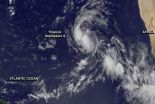(Press-News.org) BATON ROUGE – In a study that sheds light on the origin of bird species in the biologically rich rainforests of South America, LSU Museum of Natural Science Director and Roy Paul Daniels Professor in the Department of Biological Sciences, Robb Brumfield, and an international team of researchers funded by the National Science Foundation, or NSF, published a paper this week challenging the view that speciation – the process by which new species are formed – is directly linked to geological and climatic changes to the landscape.
The researchers, whose findings were published Sept. 10 in the journal Nature, found that the geographic isolation of populations within a single species is more often due to movements of birds across physical barriers, such as mountains and rivers, that occur long after the geological origin of those barriers. Their conclusions not only cast a new light on how the initial step of speciation occurred in tropical birds, but also provide a generalizable explanation for how speciation may be initiated in other regions and in other organisms.
To examine the timing of speciation, the scientists compared genetic patterns among a diverse array of bird lineages that occur in the Neotropics, one of the six major zoogeographical regions of the world extending from Mexico south to the southern most tip of South America known to have more species of birds than anywhere else in the world. Each lineage contained populations situated on the opposite side of large dispersal barriers and, with genetic data, they were able to estimate the time that the populations became isolated from one another. They found that most speciation occurred long after the origin of the Andes and the Amazonian river system.
"By using detailed sampling of many bird lineages, we were able to get a clearer and larger picture of when and how species formed within those lineages. The extraordinary diversity of birds in South America is usually attributed to big changes in the landscape over geological time, but our study suggests that prolonged periods of landscape stability are more important," said Brumfield. "Our results also suggest that human alterations of the landscape can effectively kill the speciation process. If the path to disperse from point A to point B is erased, then there is no way for the initial step of speciation to occur."
"It is probably only in birds that the genetic sampling is sufficiently dense to examine how interactions between the landscape and birds influence the speciation process," he added.
The thousands of samples used in this study represent the culmination of more than 30 years of field expeditions led by generations of LSU students and scientists, plus similar work done by ornithologists at other research institutions.
INFORMATION:
The mission of the LSU Museum of Natural Science is the acquisition, preservation and study of research collections by museum faculty, staff and students to generate knowledge of regional and global biodiversity, geological history and human history/prehistory for the benefit of the people of Louisiana, the nation and the world. For more information on the museum, visit http://www.museum.lsu.edu/. Follow the museum's Twitter, @LSU_MNS. Like the museum's LSU Big Day Peru Facebook for updates as the international award-winning birding team prepares to break the world Big Day record, http://www.facebook.com/LSUBigDay.
The mission of the Department of Biological Sciences is to create and disseminate new knowledge in the biological sciences through research; to provide for its majors the highest quality, nationally recognized, graduate and undergraduate educational programs; to provide exceptional science training to support the university's general education requirements; and to contribute expertise in support of science education in the community, including the use of available resources to improve K-12 science outreach. For more information, visit http://www.biology.lsu.edu/.
Other institutions involved in this research include the American Museum of Natural History, City College of New York, Museu Paraense Emílio Goeldi in Brazil, Universidad de los Andes in Colombia, Universidad Central de Venezuela, Colección Ornithológica Phelps, University of California Los Angeles and the University of Georgia Athens.
Related:
Peru World Big Day: Birding for Science, Fun, and Conservation
LSU Big Day Peru Website
LSU scientists lead research on speciation in the tropics
2014-09-11
ELSE PRESS RELEASES FROM THIS DATE:
Microscopic diamonds suggest cosmic impact responsible for major period of climate change
2014-09-11
Around 12,800 years ago, a sudden, catastrophic event plunged much of the Earth into a period of cold climatic conditions and drought. This drastic climate change—the Younger Dryas—coincided with the extinction of Pleistocene megafauna, such as the saber-tooth cats and the mastodon, and resulted in major declines in prehistoric human populations, including the termination of the Clovis culture.
With limited evidence, several rival theories have been proposed about the event that sparked this period, such as a collapse of the North American ice sheets, a major volcanic ...
Facebook posts reveal personality traits, but recent changes could make it harder to do so
2014-09-11
LAWRENCE — A study from the University of Kansas finds that people can accurately detect the personality traits of strangers through Facebook activity; however, changes to the social media site in the past three years could be making it harder to do so.
Researchers sampled 100 Facebook users, paralleling the demographics of the social networking site, and asked them to fill out a personality survey. A group of coders looked at each person's Facebook activity, 53 cues in all, to see whether certain personality types were more likely to do specific activities. The researchers ...
Sometimes, adolescents just can't resist
2014-09-11
Don't get mad the next time you catch your teenager texting when he promised to be studying.
He simply may not be able to resist.
A University of Iowa study found teenagers are far more sensitive than adults to the immediate effect or reward of their behaviors. The findings may help explain, for example, why the initial rush of texting may be more enticing for adolescents than the long-term payoff of studying.
"The rewards have a strong, perceptional draw and are more enticing to the teenager," says Jatin Vaidya, a professor of psychiatry at the UI and corresponding ...
Satellite view of newborn Atlantic Tropical Depression 6
2014-09-11
The sixth tropical depression of the Atlantic Ocean Hurricane Season formed in the Eastern Atlantic Ocean and NOAA's GOES-East satellite captured it.
A visible image of Tropical Depression 6 was taken by NOAA's GOES-East satellite at 7:45 a.m. EDT on September 11 as it developed. The image was created by NASA/NOAA's GOES Project at the NASA Goddard Space Flight Center in Greenbelt, Maryland.
In addition to using GOES imagery and data from other NOAA and NASA satellites, The National Hurricane Center also uses measurements from the Advanced Scatterometer or ASCAT instrument ...
NJIT researchers working to safeguard the shoreline
2014-09-11
An NJIT research team has estimated the total mass of oil that reached the Gulf of Mexico shore in the wake of the BP Deepwater Horizon blowout. It's the first time such an estimate was reported, and the study is published in the August issue of Environmental Science and Technology.
The researchers found that 22,000 tons of oil reached the Gulf shoreline in 2010. This finding will help officials determine the persistence of oil on the shore and identify potential harm to the ecosystem.
The study was conducted by the Center for Natural Resources Development and Protection ...
Penn Medicine bioethicists call for greater first-world response to Ebola outbreak
2014-09-11
PHILADELPHIA – Amid recent discussion about the Ebola crisis in West Africa, Penn Medicine physicians say that high-income countries like the United States have an obligation to help those affected by the outbreak and to advance research to fight the deadly disease — including in the context of randomized clinical trials of new drugs to combat the virus. The two new editorials, which will appear "online first" in JAMA on September 11th, are written by faculty members in the Perelman School of Medicine at the University of Pennsylvania and the Department of Social Science, ...
Unusual host preference of a moth species could be useful for biological control
2014-09-11
A team of Iranian researchers from the Rice Research Institute of Iran have discovered that Gynnodomorpha permixtana, a well-known moth species from Europe and Asia, has changed its host preferences in order to adjust to Iran's northern region environmental conditions. The importance of this adaptation for biological control of problematic weeds in rice fields and the biology of the moth on new host plant have been described in the open access journal Nota Lepidopterologica.
The larvae of G. permixtana have been so far reported to feed on the seeds and flowers of plant ...
Ebola paper demonstrates disease transmission rate
2014-09-11
Sept. 11, 2014 - New research from Arizona State University and the University of Tokyo that analyzes transmission rates of Ebola in West African countries shows how rapidly the disease is spreading.
Researchers Gerardo Chowell-Puente, ASU School of Human Evolution and Social Change Associate Professor, and Hiroshi Nishiura of the University of Tokyo found that transmission rates for each single case of Ebola consistently showed at least one new case of the disease being transmitted. Country-specific analysis of transmission rates in Liberia and Sierra Leone showed on ...
Some male scientists willing to forsake careers for family
2014-09-11
One third of men in academic science are willing to scale back their careers to focus on family life, according to researchers.
While traditional fatherhood roles may be shifting, men in the male-dominated field of academic science, such as physics and biology, face significant challenges in trying to balance work and family life, said Sarah Damaske, assistant professor of labor and employment relations and sociology, Penn State. The majority of men studied spoke of the pull of fatherhood and a desire to spend more time with children, yet they also acknowledged that academic ...
Not enough vitamin B1 can cause brain damage
2014-09-11
MAYWOOD, Ill – (Sept. 11, 2014) A deficiency of a single vitamin, B1 (thiamine), can cause a potentially fatal brain disorder called Wernicke encephalopathy.
Symptoms can include confusion, hallucinations, coma, loss of muscle coordination and vision problems such as double vision and involuntary eye movements. Untreated, the condition can lead to irreversible brain damage and death, according to neurologists at Loyola University Medical Center.
In the developed world, Wernicke encephalopathy typically occurs in people who have disorders such as alcoholism and anorexia ...



